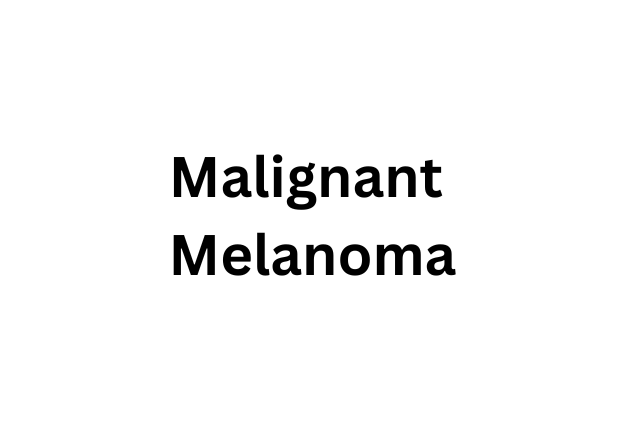Malignant melanoma is a skin cancer that begins in the skin cells called melanocytes, which produce melanin. It develops as a tumour on the outer layer of the skin.
Genetic and environmental factors both play a role in the development of melanoma, and there should be more caution taken if there is a history of melanoma among relatives.
Heavy exposures to both natural and artificial ultraviolet rays contribute to melanoma.
Melanoma continues to increase around the world and it is considered the most threatening type of skin cancer. Once considered extremely rare, melanoma is now the fifth most common cancer in men and the sixth most common cancer in women in the United States.
Globally, melanoma is responsible for 50,000 deaths every year.
Melanoma affects both the young and old, but it is most commonly found in middle-aged people. People of Caucasian descent are much more likely to develop melanoma than any other race.
Specifically, people who have fair skin, red or blonde hair, light eyes, and many moles and freckles are 50% more likely to develop melanoma.
People who are sensitive to sunlight and have a hard time tanning are also more prone to melanoma. Nonetheless, it is important to keep in mind that individuals of any race can develop melanoma.
Types of Melanoma
There are four main types of melanoma.
- Acral lentiginous melanoma. This type of melanoma is mainly present on hands, feet, fingernails, and toenails. It appears to be most prevalent in dark-skinned and Asian people.
- Lentigo malignant melanoma. These lesions develop in areas that are most frequently exposed to sunlight. This type of melanoma is most common in older people. Lesions are usually brown or black.
- Nodular melanoma. This melanoma grows into the skin and develops on the face, chest, and back. This is the most threatening form of melanoma.
- Superficial spreading melanoma. These lesions grow outwards. This type of melanoma is the most common.
Symptoms of malignant melanoma
At first, melanoma can emerge as something seemingly normal. It can materialise as a new mole or freckle, or it can grow within an existing mole or freckle. These “spots” are often brown or black, and sometimes have a combination of red, pink, grey, blue, and/or white. Within a lesion, there can be holes, dots, globules, streaks, irregular pigmentation, and/or vessels.
A lesion can be flat or raised and is typically 2 mm or less, or up to 20-30 mm. For men, the most common area for melanoma to appear is on their legs. For women, it mainly appears on their legs and arms. However, between both sexes, melanoma can also develop on the scalp and face, hands, feet, and toenails.
The ABCDE criteria will help you search for any signs of melanoma.
Asymmetry: the shape of the spot is not equal on both sides
Border: an irregular and rough looking border
Colour: brown, black, red, grey, blue or white
Diameter: the lesion can be as little as 2 mm
Evolution: remain focused on the spot for changes in size, colour, or shape
Diagnosis of malignant melanoma
It is extremely important that malignant melanoma is detected at an early stage. Furthermore, a hurried treatment is also crucial. It can take as little as weeks or as long as years to develop.
If a lesion appears suspicious, a quick skin biopsy can be completed and sent to a pathologist for testing of the skin tissue. If melanoma is detected promptly and at an early stage, there is a 90% survival rate.
If melanoma is detected at a later stage, there is a strong possibility of it spreading to the bloodstream and lymphatic system, allowing cancer to spread to other areas of the body. If a healthcare practitioner thinks this may be the case, a lymph node biopsy, CT scan, MRI, PET scan, and/or blood tests can be taken to detect cancer within the body
Other methods of diagnosing melanoma are:
ABCDE. Using the ABCDE criteria, a frequent and thorough self-examination, or by a healthcare provider, is useful in detecting melanoma.
Total-body images. For reference and analysis on skin and lesions, you or your doctor can archive total-body images.
Glasgow 7-point checklist. This form of diagnosis focuses on size, shape and colour of a lesion, as well as changes in diameter, inflammation, bleeding and scabbing.
The “ugly duckling” sign. This form of diagnosis provides the public and doctors with the idea that a spot appears unusual in comparison to others.
Optical devices. Optical devices such as dermoscopy and Reflectance Confocal Microscopy are valuable electronic tools in detecting melanoma.
Stages of Disease
The stages of melanoma vary among each case. If melanoma has increased, the lesion may become bigger, change colour, or show changes in dots, globules, holes, shape, and streaks. Sensitivity, itching, scabbing, and bleeding may also occur.
Treatments for malignant melanoma
The most common treatment for melanoma is surgery. Other treatments include skin grafting, BRAF inhibitors, immunotherapy, oral medications (Vemurafenib and Dabrafenib), targeted therapy, adjuvant therapy, chemotherapy, and lastly, radiotherapy.
Prevention
The most effective way to prevent melanoma is to protect the skin from natural and artificial ultraviolet radiation. It is important to avoid long periods of time in the sun, as well as sunburns, especially in childhood. Individuals should wear sunscreen, hats, and clothing to protect the skin.
References
Canadian Cancer Society: Melanoma. 2018, http://www.cancer.ca/en/cancer-information/cancer-type/skin-melanoma/melanoma/?region=on. Accessed 26 July, 2018.
Canadian Dermatology Association: Melanoma. 2018, https://dermatology.ca/public-patients/skin/melanoma/. Accessed 26 July, 2018.
Corrie, Pippa, et al. “Management of Melanoma.” British Medical Bulletin. 2014. 111: 149-162. Online.
Malignant Melanoma. 2018, https://emedicine.medscape.com/article/280245-overview. Accessed 26 July, 2018.
Melanoma of the Skin. 2018, https://www.ncbi.nlm.nih.gov/pubmedhealth/PMHT0024659/, accessed 26 July. 2018.
Rastrelli, Marco, et al. “Melanoma: Epidemiology, Risk Factors, Pathogenesis, Diagnosis and Classificaion.” 2014. 28: 1005-1012. Online.



